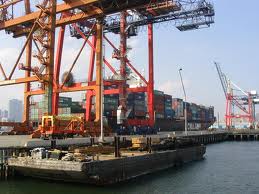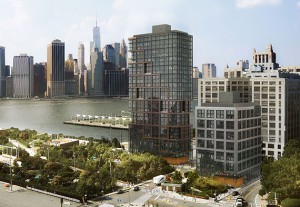When the chairman of the Port Authority of New York and New Jersey said last month that the agency should sell off its non-core real estate assets to fund projects such as the $20 billion Gateway Tunnel and a new $10 billion Midtown bus terminal, he once again stirred up the idea that some prime real estate – maybe even including the World Trade Center – could hit the market.
In fact, a little more than a year earlier a special panel of Port Authority leaders and gubernatorial advisors led by Chairman John Degnan published a report that concluded the bi-state agency should sell off assets such as the trade center, as well as sites in Brooklyn, Staten Island, the Bronx and properties across the Hudson River in New Jersey.
And while the agency has already made moves to sell interests in the Teleport industrial park in Staten Island and Bathgate in the Bronx, sources who spoke to The Real Deal said Degnan probably had a narrow set of properties in mind.
“Degnan was really just referring to the Red Hook container terminal,” said one source close to the agency, who asked to remain anonymous. “The World Trade Center site will not be sold, at least not under the current chief financial officer. The building will never recapitalize on its cost. But it will spin off significant cash that can serve as a bondable base.
“For all this talk about the Port Authority returning to its core mission, the Port Authority couldn’t exist if it didn’t have real estate assets that cross subsidize that mission,” the source added. “Degnan’s just watering the flowers to see what grows.”
The Port Authority is, of course, a highly politicized body, and sources said any real estate sale would be complicated by the perceived benefit to politicians on either side of the Hudson. Beyond that, there are obvious economic factors that would influence any potential sale.
World Trade Center
The Port Authority has options for the World Trade Center, among them is selling the fee position on the 16-acre site outright, selling the leases it has with Silverstein Properties on towers 2, 3 and 4 and selling its 90-percent interest in One World Trade Center.
But each scenario presents its own set of difficulties. Take, for instance, the option of selling the land. Because the trade center sits on property owned by the state, the Port Authority does not pay property taxes. Instead, it makes Payments In Lieu of Taxes – or a PILOT payment – a benefit that would not be transferred in a sale.
“Because it’s subject to a PILOT, there’s a whole complicated formula for real estate taxes,” said real estate attorney Ross Moskowitz, whose firm Stroock & Stroock & Lavan has advised existing and potential WTC tenants regarding PILOT agreements. “Those real estate taxes will be more subject to market conditions and could skyrocket.”
Another option for the Port Authority would be to sell its 90 percent stake in the 1,776-foot-tall One World Trade Center, which is about 66 percent full with 1 million square feet of space available. The glaring caveat with this choice is the cost.
The tower infamously came with a hefty $3.8 billion price tag, which works out to $1,266 per square foot. That’s still $44 per square foot more than what Tishman Speyer expects to spend developing its $3.2 billion, 2.8 million square foot “Spiral” office tower on the Far West Side, where land costs and market rents are significantly higher.
At a price like that, observers said, it could be tough to find a buyer, and that’s not even considering the fact that Port Authority issued substantial debt to develop the site. The agency has about $24 billion in outstanding bond liabilities, about half of which was issued to finance construction of the trade center.

John Degnan, chairman of the Port Authority
Beyond that, the building is still operating at a loss. According to the agency’s financial statements for 2105, One World Trade Center operated at a loss of $219.4 million last year. It is expected to turn a profit in the years ahead, and revenue from the leases with Silverstein for towers 2, 3, and 4 generated $264.54 million in income last year.
Once One World Trade begins turning a profit, it gives the agency an asset the Port Authority might be reluctant to give up. Experts say that for every $1 of revenue the site produces, the authority can turn around and issue $2 or $3 worth of bonds to finance other projects.
“We’re able to issue bonds against the Port Authority credit knowing we have that income stream,” said RXR Realty CEO Scott Rechler, who also serves as the Port Authority’s vice chairman. “The ground leases are a very, very safe source for our capacity to issue bonds.”

Scott Rechler, vice chairman of the Port Authority
Ultimately, when it comes to selling assets at the World Trade Center site, the decision comes down to a one-time injection of capital, or a sustained income stream.
There is another property with more flexibility that could be placed on the market — the Tower 5 site, or the location of the former Deutsche Bank building that sits just south of the World Trade Center campus proper. The site, currently zoned for 1.5 million square feet of commercial use, is owned by the Lower Manhattan Development Corporation, which struck an agreement in 2006 to swap the land for a site on the WTC campus where it would build a performing arts center.
The Bloomberg administration had pushed to convert the site to 1.2 million square feet of residential use, but the LMDC and the Port Authority have been deadlocked for the past few years over the swap. The site is reported to be valued at $300 million to $500 million.
Beyond WTC
Outside of Lower Manhattan, the Port Authority has a vast portfolio of real estate assets. They include a 50-acre mixed-use site on the Hoboken waterfront with a pair of office buildings, 526 residential units and a 265-key hotel and a waste-to-energy plant in Essex County. It also owns portions of a 12-acre industrial park in Elizabeth, N.J. as well as a legal-and-communications center in Newark that’s controlled by a private operator under a 50-year lease.
The agency controls the 80-acre Teleport industrial complex on Staten Island through a ground lease that expires in 2024. Earlier this year the authority’s board voted to carve 9 acres off from the lease and sell them to a private developer for $3.6 million, splitting the revenues from the sale with the New York City Economic Development Agency. In the Bronx, the agency’s board voted last month to sell its leasehold interest on the 454,000 square foot Bathgate Industrial Park for $16.5 million.
On the northwestern tip of Staten Island, the agency operates the 311-acre Howland Hook Marine Terminal and under a long-term lease with the city expiring in 2058, but a sale is unlikely given that the 2014 special report identified it as important to the Port Authority’s core mission, even if it does operate at a loss of $30 million.

Red Hook Terminal in Brooklyn
In Brooklyn, the agency owns a pair of properties that not only lose money each year, but are all but obsolete to the Port Authority’s mission.
In 1956, the agency began acquiring land that grew to what is now 110 acres spread across the Red Hook Container Terminal and the Brooklyn-Port Authority Marine Terminal. The latter property sits at the southern edge of Brooklyn Bridge Park where a joint venture led by Robert Levine’s RAL Development Services plans to build a pair of residential buildings with 192 condos, 30 market-rate rentals and 117 affordable rental units.

Rendering of the Pier 6 development at Brooklyn Bridge Park (credit: ODA)
But experts in Brooklyn said the Port Authority site, which is zoned for manufacturing, would most likely be used for commercial uses, such as the IKEA on the other side of Red Hook or Boston Properties and Rudin Management’s 675,000 square-foot Dock 72 office building at the Brooklyn Navy Yard.
“Anytime someone’s looking at a large development site just as this, the first idea is how to activate it from a commercial standpoint,” said Dan Marks, senior vice president at TerraCRG. “There are still plenty of [economic] incentives available for this type of development.”
The secondary option, Marks said, is residential usage.
Although the Port Authority leases a portion of the container terminal to the New York City Economic Development Corporation, the site loses money for the agency. Combined with the adjacent Brooklyn Marine Terminal, the two operated at a loss of $13.37 million last year. Both have huge redevelopment potential, with some 4.5 million square feet of development rights between them.
Jakub Nowak, an investment sales broker with Marcus & Millichap, said large development sites in the area trade at about $150 per buildable foot, which would put the total value of the Port Authority’s real estate in the area around $675 million.
But with such a large footprint, he said, the agency would have better luck breaking the site up into smaller portions and offering them up for redevelopment.
“There are not a lot of players that can fill that kind of capacity,” he said. “I think they’d be willing to pay a premium for more palatable parcels.”
